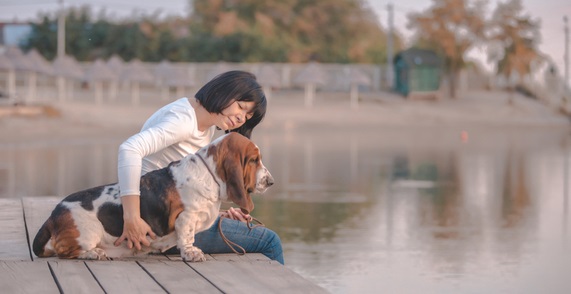People buy Basset Hounds because they have so many great qualities as a dog breed. One thing that many existing or prospective owners say they are not aware of is whether or not their Bassets can swim.
Basset Hounds can swim but their body size, shape, short legs and heavy bone structure makes it difficult to swim long distances or for too long. Because of this struggle to stay afloat, some Bassets can become a little apprehensive of water, especially when it’s deep enough so their legs can’t touch the bottom.
So you may be wondering what sort of assistance you can give to your Basset to help them swim and keep their confidence up whenever they are around water.
Why Can’t a Basset Hound Swim?
As mentioned the Basset Hound’s body shape and size are not really conducive to swimming.
A lot of the dog’s weight is at the front around the chest which makes it difficult to keep their head above water after a while. They have short legs which don’t give them much leverage to pull their long, heavy body fast enough for long enough through the water without becoming tired.
When they tire and start to sink, they can sometimes panic a little as their head goes under the surface and will look for anything that they can stand on in order to get their head back above water.

What Are The Ways You Can Help Your Basset Swim?
There are a couple of things you can do to help your Basset Hound enjoy the swimming experience safely.
1. Use a Doggy Life Vest
These are thoroughly recommended if your Basset is anywhere around water that is deep enough where they can’t touch the bottom.
Think swimming pools, lakes, rivers, on a boat etc. A life jacket fits snugly around the Bassets body, supporting the head and neck and giving them confidence that they won’t sink.
It’s preferable to get your Basset used to the jacket before you venture into the water. Some of the better jackets actually have a D-Ring that you can connect a leash to.
This means you can go for walks on land with your Basset wearing the life jacket and ‘break the jacket in’ so to speak.
Most allow plenty of room so your dog feels less constricted in their movements and include a carry handle (sometimes two) so you can pick your dog up out of the water easily if you need to.
2. Wading Beside Them While They Are In The Water
You can give your Basset confidence in the water by walking beside them as they swim. If they’re wearing a life jacket with a handle on top, it makes it easy for you to help them up or out of the water if needed.
So Do Basset Hounds Actually Like Water?
In general most dogs like water but sometimes it depends on their previous experience. If they’ve been scared or apprehensive before then chances are they will still be apprehensive when approaching a body of water and be reluctant to go in.
This makes it all the more important that you give your Basset a great experience when you’re trying to help them become comfortable around water.
What About The Beach?
Bassets are happy to splash around in the shallow water of beaches but can be wary of waves that approach that may put them into deeper water.

If they do go in the force of the water can take them out where it’s a little deeper so it’s important to be close by in case they get into trouble. Little rips can also be dangerous to an unsuspecting Basset who has ventured into the ocean beach a little too far.
Swimming Pool Safety
Although official statistics of pet drownings are not kept, most estimates put the number in the multiple thousands each year. You would probably also guess that most of those are in backyard swimming pools where pets can get in through open gates or fences.
If the dog that enters into a pool area is of a breed that struggles to swim, the odds of a drowning incident increase.
Bassets are inquisitive dogs so if you have a pool in the backyard or one is nearby, it’s really important that the pool be fenced off. If a Basset either deliberately jumps or accidentally falls into a pool, they may get into trouble quickly – they may not know how to get out or be capable of hopping out. With no one around to help them they can easily drown.
Consider your Basset Hound the way you would a child when swimming pools are nearby – be vigilant and make sure the pool gates are closed!
Forcing Them To Swim
You should never force a Basset into the water even if it is shallow. Here’s a couple of tips to get started training your Basset to swim.
1. You enter the water first and then invite your Basset in for a cuddle or a pat. Use treats as encouragement if you have to. Only do this in shallow water to begin with.
2. Once they are in with you give them confidence and encouragement to splash around with you. Cover their back with water so they get used to the feel.
3. Only do this for a few minutes and then hop out with them. Repeat the process over the next few days or weeks.
4. As they get used to the routine you can slowly go in a little deeper each time – again encouraging them every step of the way.
5. Once you are ready to get them into water that is deep enough so that their neck and head gets wet, you can start to introduce the doggy life jacket which you would have previously used on dry land when you took then for walks.
The life jacket will help with buoyancy – supporting the head and neck and reducing panic if they accidentally fall or slip over and their head goes under water. The life jacket will quickly bring them up again if that happens.
Here’s what the end result can look like…
More Points To Consider..
** Only use shallow water to start with – let them have a pleasant experience splashing around in shallows so they get used to water and don’t see it as scary.
** Once they graduate to water a little deeper where they can’t reach the bottom they can start wearing their life jackets so they don’t start sinking. Making sure they don’t have a bad experience is important because if they do, it may be difficult to coax them back in the water in future.
** They do need to keep their head above the water which is difficult because this is where most of the bone mass is. That’s why it’s important to have a good dog life jacket that has extra flotation around the head and neck.
** They need to be able to get out of the water easily so make sure there are steps, stones or something else they can walk on to get out whenever they want to.
** Don’t take them swimming if they’re tired. There’s more chance they will get into trouble if they don’t have the energy to swim.
Ear Cleaning After Swimming
Bassets have long been susceptible to ear problems and these can be made worse after they have been in water, especially if it’s chlorinated pool water.
Even in shallow rivers there can be microscopic organisms that can get inside your Bassets ear and cause problems.
Make sure you wash your Basset’s ears with clean water after swimming especially when their head has been underwater for any length of time.
Because of the Basset Hounds big floppy ears there just isn’t the air flow through the ear canal to evaporate the moisture sufficiently. The moisture can then build up to the point that infections can occur – especially yeast infections which can be a real problem if left unchecked.
So after swimming or being immersed in water remember to take the time to check, dry and clean the ears.
Final Thoughts
The bottom line is although Basset’s can swim they can often be reluctant to enter into any body of water that is too deep. They may wander in but as soon as they realize it’s getting deeper they will often walk straight out again.
Even if you go through the steps I just outlined above to help them be more confident in water there’s still no guarantee they will want to do it in future. It really depends on your individual dog as it is with most things canine.
Following these steps however will give you dog the best chance of learning to love the water.
There are some Basset hound owners who report that their dogs love to swim. Whether yours will be one of them you won’t know until after you start the process of teaching them.
Recommended Reading: >> Are Basset Hounds High Maintenance?
Elise is the owner of HMD. She has spent her whole life around dogs starting from when she was growing up on her parents farm. She is a prolific writer and blogger who passionately writes about her love for her canine friends.

